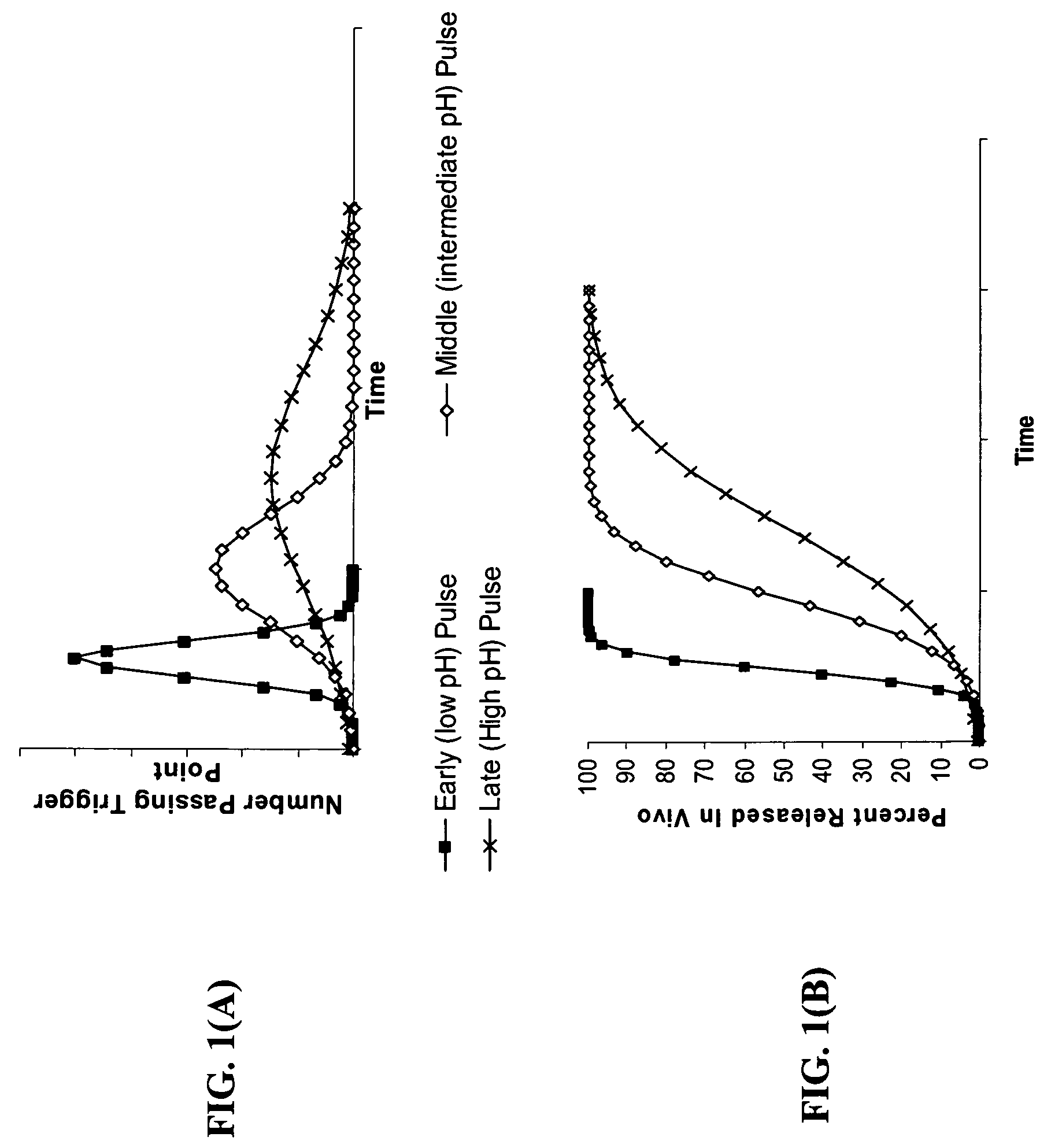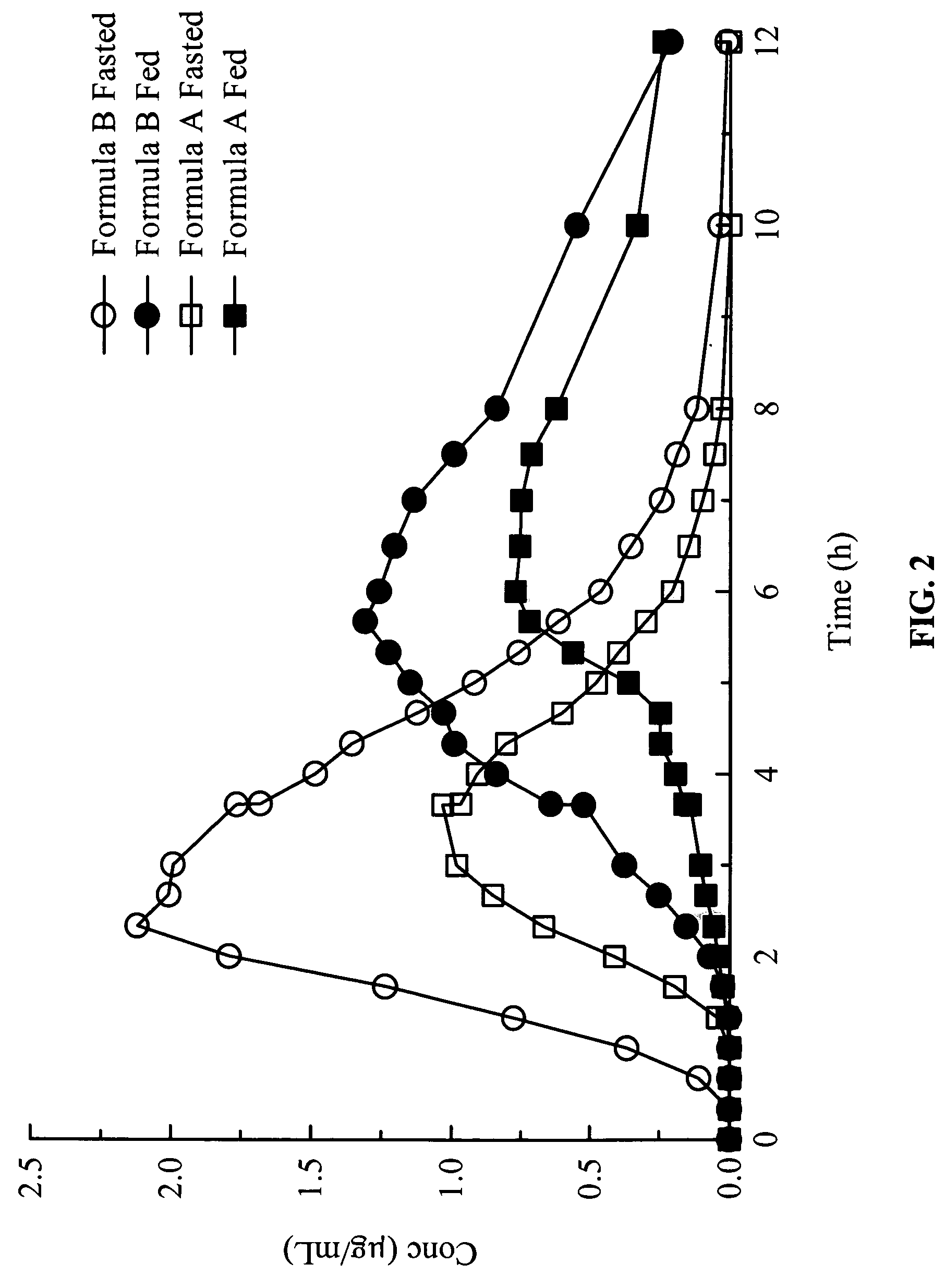Gastric release pulse system for drug delivery
a gastric release and pulse technology, applied in the field of pharmaceutical products, can solve the problems of insufficient rate, insufficient ph-dependent multiparticulate or microparticulate systems, and insufficient pulses, etc., and achieves improved disease treatment, high bioavailability, and high incidence of side effects.
- Summary
- Abstract
- Description
- Claims
- Application Information
AI Technical Summary
Benefits of technology
Problems solved by technology
Method used
Image
Examples
example a-1
Metro Pellets (P1)
[0090]A dosage form for the pulse one (P1) delivery of metronidazole was prepared as follows: 15 g of Cremophor EL, 60 g of Povidone K25, 50 g of sucrose and 75 g of corn starch were dispersed in 800 g of water (20% solids) and heated to 80-85° C. for 5 minutes. A uniform paste was formed and allowed to cool to room temperature. The resultant paste was granulated with 500 g of micronized metronidazole, 140 g of Avicel PH101, and 160 g of L-HPC. The granulation was extruded through a 0.8 mm screen and spheronized into pellets. The pellets were dried in an oven at 50° C. until the moisture content determined by loss on drying (LOD) was less than 3%. Pellets passing through a 16 mesh screen and retained on a 30 mesh screen were collected with the following composition:
[0091]
COMPONENTWT %Metronidazole, micronized50.0%Avicel PH10114.0%L-HPC (LH-BB1)16.0%Sucrose5.0%Povidone, K256.0%Cremophor EL1.5%Corn Starch7.5%Total100.0%
example a-2
Metro Pellets (P2L1)
[0092]Pellets from Example A-1 were coated with two functional layers in order to achieve a lag time followed by quick release of drug. A “push” layer that swells when hydrated was applied to the pellets to help rupture the outer coating in order to achieve the quick release of drug once the lag time has passed. PVP and Ac-Di-Sol were dispersed in Isopropanol and sprayed onto 500 g of pellets to a 40% solids weight gain using a bottom spray fluid bed coater with an inlet temperature of 50° C. and parameters sufficient to maintain an exhaust temperature around 40° C. After the “push” layer, a layer was applied to protect the inner drug core from dissolving for a set period of time. Ethocel, Methocel, Talc, Cabosil and TEC were dispersed in a hydro-alcoholic solution and the functional layer was applied to 500 g of pellets at a 40% solids weight gain using a bottom spray fluid bed coater with an inlet temperature of 60° C. and parameters sufficient to maintain an e...
example a-3
Metro Pellets (P3L2R1)
[0094]Pellets from Example A-1 were coated with three functional layers in order to achieve gastric retention for a period of time followed by quick release of drug once the pellets empty from the stomach. A “push” layer that swells when hydrated was applied to the pellets to help rupture the outer coating in order to achieve the quick release of drug once the pellets leave the stomach. HPC and Ac-Di-Sol were dispersed in isopropanol and sprayed onto 500 g of pellets to a 40% solids weight gain using a bottom spray fluid bed coater. After the “push” layer, an enteric polymer layer was applied to protect the inner drug core from dissolving in the stomach. An Eudragit L30D-55 dispersion was prepared with TEC and Talc and the enteric layer was applied to 500 g of pellets at a 20% solids weight gain using a bottom spray fluid bed coater. After the enteric layer a mucoadhesive layer was applied in order to achieve dose form retention in the stomach. A dispersion of ...
PUM
| Property | Measurement | Unit |
|---|---|---|
| diameter | aaaaa | aaaaa |
| particle size | aaaaa | aaaaa |
| diameter | aaaaa | aaaaa |
Abstract
Description
Claims
Application Information
 Login to View More
Login to View More - R&D
- Intellectual Property
- Life Sciences
- Materials
- Tech Scout
- Unparalleled Data Quality
- Higher Quality Content
- 60% Fewer Hallucinations
Browse by: Latest US Patents, China's latest patents, Technical Efficacy Thesaurus, Application Domain, Technology Topic, Popular Technical Reports.
© 2025 PatSnap. All rights reserved.Legal|Privacy policy|Modern Slavery Act Transparency Statement|Sitemap|About US| Contact US: help@patsnap.com



